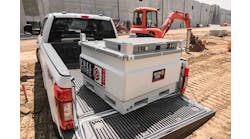Materials Costs and Bid Prices Jump as Dodge Starts Rise, AGC Reports
Construction input costs and bid prices both accelerated in January, according to Bureau of Labor Statistics data posted last week. The producer price index (PPI) for material and service inputs to new nonresidential construction climbed 2.6 percent for the month (up from 0.9 percent in December) and 20 percent year-over-year (y/y).
The PPI for new nonresidential building construction—a measure of the price that contractors say they would bid to build a fixed set of buildings—increased 3.8 percent for the month and 17 percent y/y, the most in the series’ 12-year history. (The data are not seasonally adjusted; many producers institute price increases in early January, which may explain the outsized one-month increases. In addition, the bid-price index is based in part on data from cost-estimating firms that BLS incorporates only in January, April, July, and October. Thus, the January increase reflects three months of materials cost changes as well as the monthly change in contractors’ estimated overhead and profit margins.)
Numerous input PPIs rose sharply for the month and/or year. The PPI for steel mill products soared 113 percent y/y despite declining 1.6 percent for the month (the first decrease since August 2020). The index for diesel fuel jumped 5.1 percent in January and 57 percent y/y; plastic construction products, 1.8 percent and 35 percent, respectively; aluminum mill shapes, 5.6 percent and 33 percent; copper and brass mill shapes, 4.1 percent and 25 percent; architectural coatings, 9.0 percent and 24 percent; gypsum products, 4.9 percent and 23 percent; lumber and plywood, 15 percent and 21 percent; insulation materials, 4.6 percent and 19 percent; asphalt felt and coatings, 1.1 percent and 18 percent; and truck transportation of freight, 1.3 percent and 18 percent.
Bid prices, as measured by PPIs for new buildings, rose by record amounts: 6.3 percent for the month and 28 percent y/y for new warehouse construction; 4.3 percent and 18 percent, respectively, for industrial buildings; 4.1 percent and 17 percent for offices; 2.9 percent and 15 percent for health care buildings; and 2.9 percent and 12 percent for school buildings. PPI increases for new, repair, and maintenance work by subcontractors amounted to 1.8 percent for the month and 19 percent y/y for concrete contractors; 4.7 percent and 14 percent, respectively, for roofing; 1.3 percent and 11 percent for electrical; and 0.8 percent and 9.9 percent for plumbing contractors. AGC posted tables and graphs of construction PPIs. On February 9, AGC posted the February edition of its Construction Inflation Alert, an 8-page document intended to inform owners, officials, and others about recent developments affecting materials costs, supply chains, and worker wages and availability. BLS released its annual reweighting of PPI inputs on February 11. Readers are invited to email [email protected] to receive the BLS Excel files of the “relative importance weights” for inputs to each type of construction or to send information about prices and supply-chain issues.
Construction starts increase in January
Total construction starts in current dollars (i.e., not inflation-adjusted) increased 4 percent from December to January at a seasonally adjusted annual rate, data firm Dodge Construction Network reported on Wednesday.
“Nonresidential building starts increased 4 percent and nonbuilding starts rose 18 percent,” said DCN. “Residential starts fell 1 percent. Compared to one year ago, total construction was 8 percent higher in January 2022 than in January 2021. Nonresidential building starts were up 14 percent, nonbuilding starts rose 12 percent, and residential starts gained 2 percent. For the 12 months ending January 2022, total construction starts were 13 percent above the 12 months ending January 2021.”
Nonresidential building starts were 14 percent higher, with gains of 11 percent for commercial starts, 8 percent for institutional starts, and 82 percent for manufacturing starts. “For the 12 months ending January 2022, residential starts improved 19 percent from the 12 months ending January 2021. Single-family starts were 2 percent lower, while multifamily starts were 26 percent stronger.”
Nonbuilding starts were up 3 percent, with environmental public works up 22 percent, utility/gas plants up 4 percent, highway and bridge starts down 1 percent, and miscellaneous nonbuilding starts down 16 percent.
Housing starts (units) slid 4.1 percent at a seasonally adjusted annual rate from December to January but edged up 0.8 percent y/y from the January 2021 level, the Census Bureau reported. Single-family starts declined 5.6 percent for the month and 2.4 percent y/y. Multifamily (five or more units) starts slipped 2.1 percent for the month but increased 8.7 percent y/y. Month-to-month and y/y comparisons of starts in winter months can be significantly affected by unusually mild or harsh weather in the months being compared. Residential permits increased 0.7 percent from December and 0.8 percent y/y. Single-family permits increased 6.8 percent for the month but decreased 5.0 percent y/y. Multifamily permits slumped 8.8 percent for the month but rose 12 percent y/y. The number of authorized multifamily units that have not started—an indicator of potential near-term starts—soared 44 percent y/y. Census announced that “the monthly Building Permits Survey design has changed from a representative sample to a cut‐off sample. This change allows complete local and county data on new housing units authorized by permits to be published monthly.”
Cryptocurrency-related construction booms
“Bans on cryptocurrencies overseas have led to a surge of crypto- and Bitcoin-related construction in the U.S., adding more demand in the already booming data center sector, industry sources said,” Construction Dive reported. “The surge in Bitcoin mining centers mirrors the overall trend in the data center industry. Around 527.6 megawatts were under construction midway through 2021, an increase of 42 percent [y/y, according to commercial real estate services and investment firm CBRE]. Texas leads the U.S. as a favored landing spot for these projects for its low cost of power, said Mikey Jaillet, associate at CBRE's data center group. Texas is on track to deploy approximately 5,000 megawatts of cryptocurrency mining data centers by 2023, said Lee Bratcher, president of the Texas Blockchain council, in an interview with Bloomberg. That's around five times more than the current rate, said Jaillet. Other leading crypto construction destinations include Georgia and Wyoming, said [Ryan Ferguson, vice president and project executive of mission critical at McCarthy Building Cos.], for their inexpensive power, renewable energy and access to fiber.”







